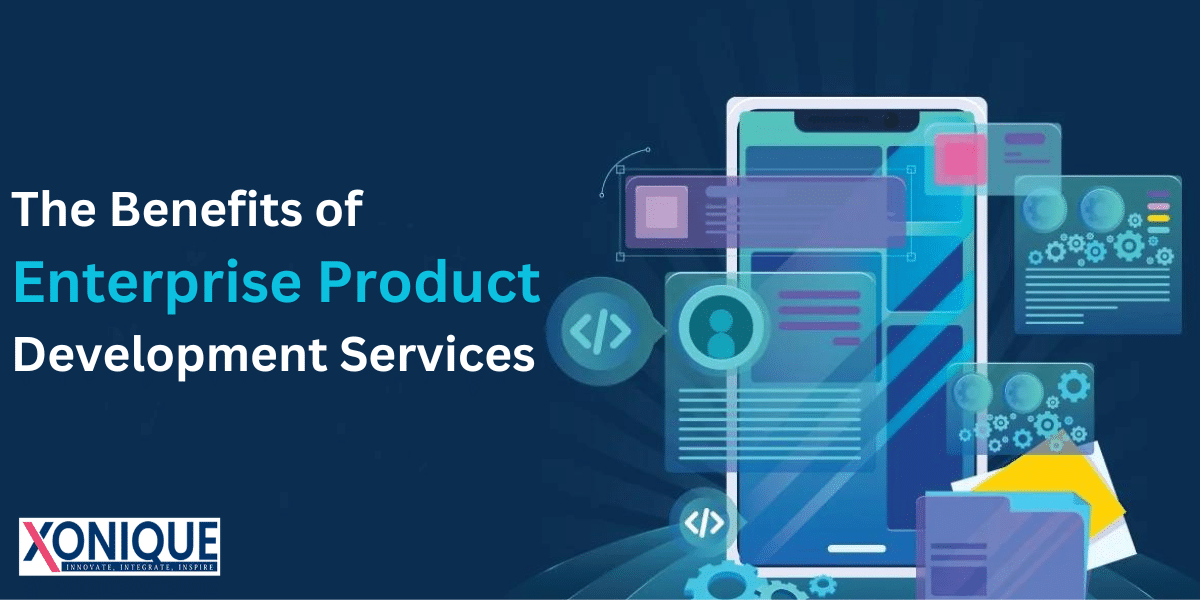Announcing a brand-new product may be both an exhilarating and a daunting process. The development path can be arduous, no matter if it’s digital or physical. An organized method for developing products will aid in simplifying and streamlining the procedure. Connecting with your target audience as broadly as feasible through the internet is crucial.
Your target customers are faster, irrespective of whether your business operates in the printing or textile sector. Building a software development team independently is only sometimes practical or feasible. With the rapid pace of change, Enterprise Product Development Services have been the preferred solution for security and privacy concerns. To access all the benefits of solutions for enterprise mobility, working with a software development firm is essential.
Enterprise product development is the method that tracks software developments that meet the client’s particular specifications. The end product created through this method is completely customized to improve the users’ experience with B2B or B2C customers of the company. Businesses typically utilize product development for enterprise. Development of products is the procedure of changing a client’s notion and requirements for an item or service into an appropriate software application.
This blog will explore the advantages of enterprise product development services.
What Are Enterprise Product Development Services?
Your success with your company products will depend on the technology you use to meet your customers’ needs. Enterprise product development is developing and improving software products specially designed for large businesses or large enterprises. The solutions designed are created to satisfy the unique demands and needs of companies that operate at a large size. Companies, schools, non-profit organizations, and even government officials frequently utilize product development for enterprises.
Every day, the standards are continually raised to meet the needs of each release of a new software version. However, with all these developments that affect software design for businesses, the user experience is the most crucial aspect to consider. Enterprise product development is an excellent method to provide a superior consumer experience by utilizing customized software.
What Is a Product Development Strategy?
An effective strategy must be developed for any new and revamped products. Creating a compelling product plan is a matter of defining the goals for the product. The primary objective is to outwit the unpredictability and aggressive forces in the marketplace so that your product is successful. It is, therefore, essential to know the ins and outs of your target market. Product strategy is similar to planning right from the start to create the product. You decide what you’d like to use for your new product. You should know why you’re making your product before deciding what you want to accomplish and the way.
A product development strategy refers to the techniques and initiatives used to introduce new products to the market or modify/recreate/rebrand existing ones to cultivate new business opportunities. From the conception of an idea to the launch of a final product, there are many stages in product development. To achieve success and increase revenues for your company, it is essential to have a carefully planned strategy with the help of your Enterprise Product Development Company. A properly planned journey through product development helps ensure that your products address challenges, are easy to use, and, most importantly, will please the end customers.
Benefits Of Enterprise Product Development Services For Businesses
A well-designed item can compete and be desirable in the marketplace. An item that has been developed and is sought-after can bring numerous benefits, even if multiple external factors could influence the product’s success.
Good Reputation
Use your name and your business name for each item you launch. The reaction the product gets will reflect the brand you are promoting. The product can be branded as creative, good quality, and inexpensive, among other factors, by presenting a well-designed product. An excellent reputation will make your brand popular. Popularity will increase sales, but could also boost enthusiasm for the new product and the latest models. An outstanding reputation could offer free advertising via news publications, blogs, and word-of-mouth.
Growth
Expanding is the only way you can ensure that your company is successful. There must be more than the minimum amount of work to ensure it is alive. An effective launch of a product and advancement can boost profits for your business and allow it to grow in terms of financial resources, create additional products, and invest in technology, marketing, and many other areas. Growth isn’t just about profitability; selling is usually the main priority. Growth from developing high-quality products can result from gaining more significant market share or access to new markets.
Keep up-to-date
The same is true for you’d like to use your new product to enhance your brand’s reputation and expand your business. Developing a product aims to make an item competitive in today’s marketplace. Even famous, well-established software companies must release updated products or new versions throughout the year or each period to stay ahead of the market’s changing demands and keep from appearing outdated to consumers. Businesses that don’t keep up with current trends and consumers’ preferences will likely slow down and fall behind the competition. The development of products is essential to keep your business thriving in an environment that changes constantly. Innovative products help attract your company’s attention, contributing to its image and growth.
Manufacturing Quality & Cost
An effective product development procedure produces the product being of top quality and also a manufacturing procedure that runs smoothly. Ensuring your product is as simple as possible without degrading its quality is essential. An easier and faster manufacturing procedure can lead to less production expenses and greater profits.
Concept Of Tangibility
The tangible object that can be felt yelled at, or experienced differently will create a more powerful influence on investors than the concept itself. Your idea can be transformed into a tangible item with meticulous design and creation. It is the first step in developing a product that, if completed correctly, could be the ideal method to present your idea to potential investors or even test markets. It’s a vital stage if you plan to obtain funding from an outside source because you can explain to investors how the product can be used. An unplanned or poorly executed product creation process could not produce the results to impress investors with your ideas.
Phases Of The Enterprise Product Development Process
Developing new Enterprise Product Solutions is a process that involves bringing innovative ideas to the market. Companies can analyze and assess the different aspects of launching a new product. What steps are involved in the process of developing a product? Here are the steps of the process of designing products for enterprises.
Research On Market And Customer
It is crucial to realize that the reason behind new products is to fulfill customers’ demands. This is accomplished by creating a gap within the market or by creating a better product. You know the person you want to appeal to and the competitors within the niche. You should study your customers’ behavior and attitudes to establish if there’s an actual need for the product you’re looking at. Also, it is essential to find out who your competitors are. This information will allow you to determine the answer to your most important question: “Will it sell? “The data from these two kinds of research will aid you in deciding if your product is an excellent match for a particular market. It yields a profit from your investment, improves your value as a brand, and keeps sales going throughout the lengthy lifecycle of the product.
Initial Design And Ideation
Now is the time to decide on the “how” of your product. Your shower plan sketch or napkin concept for a revolutionary technology is transformed into a tangible product. The first stage is referred to as the conceptual or initial design. Ideation is an excellent approach to start. This is an active procedure that requires you to create brief sketches of the design and the purpose for which it serves. The process usually involves several sketches and prototyping. The balance between aesthetics and practicality differentiates quality items from outstanding ones. In the end, functionality remains the main element. Check these out with your customers and market research to develop a list. Repeat the process of iterating and changing the concept until it’s your desired product.
Product Engineering And Feasibility Study
At the engineering stage, you test the concept to determine if the product suits your client’s requirements and generates revenue for your business. Your design team might have been defining things with a more abstract approach until the present. The time has come to pay closer attention to details and to do it in a planned manner. Product engineering involves creating a product that can be made and includes every feature and function necessary to satisfy your customers’ requirements.
This process results in a thorough design that fully describes the final product. You may require additional details according to the industry you work in and the end product. During this phase, there will be a need to make several choices. It is crucial to be sure that your options are of sufficient value for your client to buy the product. Most entrepreneurs need to know how much work is involved in developing a product. Producing your designed product is possible if you devote the necessary time. Ultimately, you could be making a design that can’t be manufactured. Before proceeding to the next development phase, it is essential to consider whether the product you intend to introduce is viable. There is a way to develop your product, but is it feasible to implement logistically? If not, you risk spending your time and money to create an idea that will never be realized.
Identify Manufacturing Partners
You should seek manufacturing partners when you start the engineering and feasibility tests. This business or network can make your concept something you can experience, feel, and, most importantly, purchase. Consulting with experts or other organizations can accelerate your development time and help reduce errors. As you would when developing the design, it’s essential to research the manufacturing partners. You’re putting your design process in danger if you are not aware of their capabilities and the price they charge. Making corrections when you increase production could be costly.
Prototype Development
It is recommended that your team begin creating prototypes when you’ve got a clear concept of your product. Physical models can answer questions about your product’s style and aid in taking the market analysis to an entirely new degree. The possibility exists to view the design, experiment with it, get potential customers to provide feedback, and consider different options. A prototype could be a simple cardboard cutout, digital mockup, physical model created with easily shaped material or 3D printing, or a working prototyping made by your manufacturer. Iterative processes are a great way to improve your product development. It is essential to incorporate this process into your company’s processes.
Testing
Iteration and testing are two steps in the development procedure. It is essential to plan the testing process by identifying the types of tests that will be performed, the metrics used to evaluate the product, and the resources needed. Actual Analysis of the Product Using the Planned Tests. Test results are recorded, analyzed, and utilized to determine improvement areas.
Based on the outcomes of the tests, the product can be altered to enhance its performance or fix any issue. The modifications can be as simple as changing the product’s appearance, changing the functions, or fixing problems discovered during tests. It is tested again after adjustments have been made to verify that the changes have been successful and that no new issues are arising due to the changes.
The process of testing and iteration will be repeated until the final product is at the degree of quality and performance. Before the final product can be created, it’s important to evaluate several item variations. It is essential to address any flaws or issues with the product to meet the needs and expectations of the person using it.
Production Plan
Starts in the final phases of prototyping and engineering. Create a document outlining each step of the process and all resources needed to develop your product. This includes material, equipment, and manufacturing methods. This document also covers the scheduling, capacity, and staffing. Visual representation of the various entities involved in the production of your product at different phases, including manufacturers, suppliers, and distributors.
An outline of the steps and people responsible for evaluating and maintaining the quality of your products. This phase involves finding every component and designing and purchasing custom tools. Each manufacturing stage is created, and a tracking and inspection system is installed to ensure quality control.
Product Manufacturer
Now is the time to commence production of your new product. However, this only sometimes means the product development team accomplished their job. Iterative and collaborative: The process of producing your product has a similar structure to other phases of development. Lean manufacturing is an excellent method to boost your company’s efficiency and reduce waste at every manufacturing phase. To make improvements, you must be able to measure and monitor the quality.
How Do You Ensure That Enterprise Product Development Services Meet The Finest Standards?
Product development is critical for businesses looking to stay ahead in today’s marketplace and remain successful. Many aspects ensure that the products you develop are of the best quality. Below are some of the most important factors to consider:
Employ Experienced And Skilled Professionals
If you’re developing products, you must ensure that you’re working with experts with an established history of accomplishment. Find companies that have an impressive portfolio of success with customers and products.
Determine Your Objectives And Goals
Before beginning any new product design project, you must clearly define your objectives and goals. What goals do you intend to accomplish with this product? What are the requirements it needs to satisfy? Having a concept of your objectives right from the start will ensure that your team of product developers is determined to do the right thing.
Communicate Effectively
Communication is vital to the success of any project for product development. It is essential to have regular discussions and reports with the team responsible for developing your product so that everyone is on the same team.
You Should Be Prepared For Pivots
While the development of your product develops, you might discover that the original objectives and targets must be re-evaluated. It would help if you were prepared to adjust your plans and pivot whenever necessary. The flexibility you have will allow you to make sure that the final result is the very best you can make it.
Concentrate On The Quality
Throughout the entire development process, you must ensure that quality is at the forefront of your mind. Working with reliable suppliers and producers who produce top-quality components would be best.
If you follow these guidelines, you will be able to ensure the services you provide for product development will be of top standard, with the help of experienced experts by defining your objectives by communicating clearly, as well as having the ability to pivot when needed to adapt your ideas into reality and develop an item that will meet the demands of your targeted audience.
Common Pitfalls To Avoid When Developing Enterprise Product Development
Let’s look at the common mistakes to avoid when developing an enterprise product.
Inclusion Of Critical Stakeholders
An error that must be avoided is leaving important stakeholders out of the formulation of your vision for your product. Everyone involved, including executives, customers, and designers, possesses essential insights. They can be included to provide an entire perspective. By excluding them, you’ll have only a small vision.
The Failure To Conduct Market Research
If you are defining the vision of your product, make sure to conduct a market study. Knowing the marketplace and customers’ wants is vital. Utilize a thorough analysis to uncover customer trends, challenges, and opportunities. Use the data to enhance your vision for the product.
There Is A Lack Of Clarity In The Vision Of The Product
Lacking a clear vision of your product is a frequent oversight. The team may be confused and inefficient if they don’t have a clear and concise product vision. Make sure you clearly articulate your vision for the business. The value proposition, the market you want to target, and long-term plans should be clearly defined.
Underestimating Or Overcommitting Timelines
If you aren’t aware of the deadline for your project, errors could be made. Extended deadlines may cause a waste of resources and result in rush projects. Examine dependencies and requirements and involve the development team in making realistic deadlines. Re-evaluate and alter the time frame According To Comments And Developments.
Disregarding Feedback From Customers As Well As Market Validation
Developing a product could be negatively impacted by needing to collect users’ feedback. This could result in the product being unable to reach those who tend to use it. The solution includes users throughout the design process. Collect feedback, conduct user tests, and refine the results based on the input.
Be Flexible With Your Road Map
A rigid plan can cause it to be challenging to adjust to changing circumstances, and it might need to be able to keep up with the latest requirements or customer needs. Develop a flexible roadmap that balances long-term and short-term objectives. Regularly update the road map to incorporate new data. Concentrate on the most critical aspects.
Summary
Growth-driven by-products is an excellent strategy to secure your increase. But, it’s only feasible with a solid approach to product development. Your journey to develop your product will be easier and more effective with scalable and agile teams upon demand. If you follow these steps throughout the product development process, you can make your product. This can help simplify the difficult job of bringing a brand-novel product to market in smaller parts.
Enterprise Product Development services are strategic approaches that deliver the best value to clients and should be viewed as strategic plans. It is a commitment to invest across multiple areas. Learning about your customers, creating internal efficiency, and aligning with all of your strategy’s priorities.











